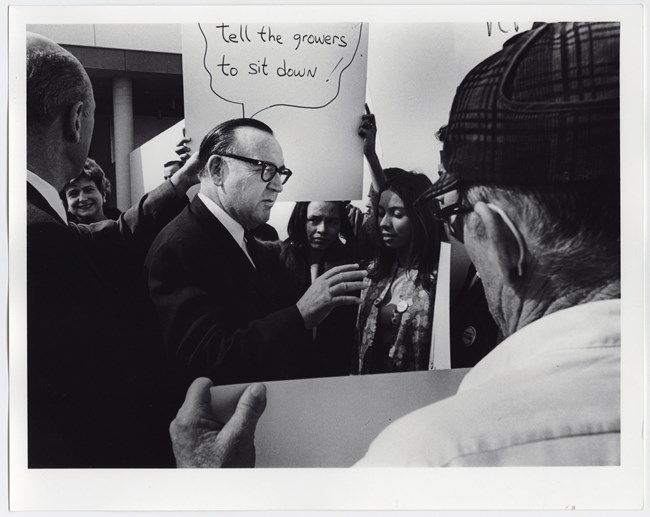Part of a series of articles titled The Road to Sacramento: Marching for Justice in the Fields.
Previous: Mobilizing Support for La Causa
Article

Jon Lewis Photographs of the United Farm Workers Movement. Yale Collection of Western Americana, Beinecke Rare Book and Manuscript Library.
As the march grew closer to Sacramento, participants swelled into the thousands. And, only a few days before the finish, the National Farm Workers Association (NFWA) announced a major break through - a historic agreement with Schenley Industries, the second largest grower in Delano. This article highlights the victory as well as the farmworkers' future struggles.
The union had its first taste of victory before the march was even complete. A little more than midway through, Cesar Chavez was contacted by an attorney for Schenley Industries, which had been targeted by the NFWA’s boycott since December. Although the campaign had not yet had a significant economic effect on Schenley, the publicity was beginning to tarnish the company’s image. On April 6, 1966, representatives from Schenley and the NFWA announced their historic agreement, in which the company recognized the small, independent union as the sole collective bargaining agent for its workers.
The contract with Schenley was just the beginning. Almost all of Delano’s other grape growers remained steadfast in their refusal to negotiate with the upstart farmworkers’ union. Schenley was just one vineyard, and its fields represented only a small fraction of California’s vast agricultural industry. But the Schenley victory had more than symbolic importance. It revealed the power of farm workers to effect real change in their lives. It demonstrated how the changed social and political landscape of the 1960s offered new and potent organizing opportunities for farmworkers. The Delano to Sacramento march marked a key moment in the civil rights struggles of the era, a turning point in the history of labor and of La Causa.
Bibliography
Bardacke, Frank. Trampling out the Vintage : Cesar Chavez and the Two Souls of the United Farm Workers. New York: Verso, 2011.
Levy, Jacques E., and Chavez, Cesar. Cesar Chavez: Autobiography of La Causa. 1st ed. New York: Norton, 1975.
Shaw, Randy. Beyond the Fields: Cesar Chavez, the UFW, and the Struggle for Justice in the 21st Century. Berkeley: University of California Press, 2008.
Part of a series of articles titled The Road to Sacramento: Marching for Justice in the Fields.
Previous: Mobilizing Support for La Causa
Last updated: March 20, 2025